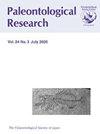Producing Processes of the Trace Fossil Asteriacites lumbricalis Revisited: Different Ophiuroid Behaviors Produce Different Trace Forms
IF 0.6
4区 地球科学
Q3 PALEONTOLOGY
引用次数: 0
Abstract
Abstract. The star-shaped trace fossil Asteriacites lumbricalis is produced by ophiuroids and has two different forms. One form has four distinct arms with transverse fine and parallel striations and one indistinct arm without striations, and the producing process has been studied already. In this study, we clarified the producing process of another form with five distinct radiating arms and fine striations by aquarium observations of extant ophiuroids. The form was produced when ophiuroids were covered with a thin sand layer (11–39% of the arm length in thickness). After covered by thin sand, ophiuroids raised their five arms with one to five tips protruded vertically above the sand cover, raised and slanted the disc in the sand, and then obliquely emerged onto the sand cover. Finally, they returned to horizontal postures creeping on the sand. The trace left on the substratum was very similar in shape to the trace fossil from Hettangian (Lower Jurassic) in Blumenrod, Germany. The producing process of the repetitive multiple traces of A. lumbricalis was revealed by aquarium observations. When an ophiuroid was alternately covered with a thin sand layer and then with a thin abrasive layer as mud substratum, the ophiuroid left a vertically stacked series of traces which gradually shifted the horizontal position. This unique form of A. lumbricalis was produced by escaping of ophiuroids from successive deposition events.对腰痛小行星遗迹化石产生过程的再认识:不同蛇夫座行为产生不同的遗迹形态
摘要星状的痕迹化石腰痛小行星是由类人猿产生的,有两种不同的形式。一种形态有四个明显的臂,具有横向细而平行的条纹,一个不明显的臂没有条纹,并且已经对其产生过程进行了研究。在这项研究中,我们通过水族馆对现存类人猿的观察,阐明了另一种具有五个不同辐射臂和细条纹的形态的产生过程。这种形状是在蛇神体被一层薄砂层(厚度为臂长的11-39%)覆盖时产生的。在被薄沙覆盖后,蛇神星举起它们的五只手臂,其中一到五个尖端垂直突出在沙盖上方,在沙子中升起并倾斜圆盘,然后倾斜地出现在沙盖上。最后,他们恢复了在沙滩上爬行的水平姿势。底质上留下的痕迹在形状上与德国布卢门罗德下侏罗纪和塘店的痕迹化石非常相似。通过水族箱的观察,揭示了腰痛重复多痕迹的产生过程。当小行星交替覆盖一层薄砂层和一层薄研磨层作为泥浆基质时,小行星留下了一系列垂直堆叠的痕迹,这些痕迹逐渐改变了水平位置。这种独特形式的A.腰痛是由连续沉积事件中的类人猿逃逸产生的。
本文章由计算机程序翻译,如有差异,请以英文原文为准。
求助全文
约1分钟内获得全文
求助全文
来源期刊

Paleontological Research
PALEONTOLOGY-
CiteScore
1.60
自引率
0.00%
发文量
47
审稿时长
>12 weeks
期刊介绍:
Paleonotological Research (PR) is a quarterly, peer-reviewed international journal, which focuses on original contributions primarily in the area of paleontology but also covering a wide range of allied sciences. It has been published since 1997 as a successor to the former journal Transactions and Proceedings of the Palaeontological Society of Japan. The emphasis of contributions will include global and local perspectives, and contents can cover all ages (Precambrian to the Quaternary, including the present time).
 求助内容:
求助内容: 应助结果提醒方式:
应助结果提醒方式:


